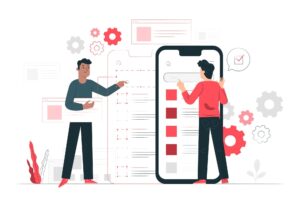
Uber and similar companies have played a big role in making the ride-hailing market expand faster than before. To create an app like Uber, you should first understand the basics of building such a system. It outlines the essential building blocks and important technologies you need for such an application.
Understanding the Key Features of Ride-Hailing Applications
It is very important for a ride-hailing app to have a smooth user experience, effective back-end systems, and real-time features. Mainly, the features in a Bolt clone, Uber clone, or another ride-booking solution are the same.
- User Panel: In the User Panel, guests can access sign-up/login, book a ride, estimate fares, keep track of their order in real time, and make payments.
- Driver Panel: The driver panel includes requests for rides, navigation support, past earnings check, and information on the driver’s availability.
- Admin Panel: In the Admin Panel, you can track each trip, set fares, confirm drivers, and look at user statistics.
They all have to cooperate for the both the drivers and riders to have a smooth experience.
Selecting the Right Technology Stack for Your Application
A well-designed tech structure that keeps up with real-time activities and large users is what’s needed to build an app like Uber.
Frontend Technologies:
- React Native or Flutter: For cross-platform mobile app development
- Swift or Kotlin: For native development on iOS and Android
Backend Technologies:
- Node.js / Django / Ruby on Rails: Handles API logic and data processing
- MongoDB / PostgreSQL: For database management
- Firebase / Twilio / SendBird: For push notifications, SMS, and chat features
APIs and Services:
- Google Maps / Mapbox: For geolocation and route optimization
- Stripe / PayPal / Braintree: For secure in-app payments
- AWS / Google Cloud: For hosting, scalability, and performance
GPS and Real-Time Tracking Are Central to Functionality
Location-based services help any ride-hailing app by providing instant tracking information on drivers and rides.
It is common to display maps, measure distances, and guide people step by step with technologies such as Google Maps API and Mapbox SDK. Back-end systems should deal with new location changes in just a few milliseconds to achieve accuracy.
Matching Algorithms for Connecting Riders and Drivers
The main aspect of ride-hailing is a matching algorithm that works well. A request from a rider means the system should instantly find the nearest available driver. Some of the usual strategies include:
- By using geohashing, archaeologists search nearby places.
- The use of priority queues in situations with great demand
- Smart algorithms that depend on the availability of drivers and the choices of users
Using these algorithms helps provide quick matches, which makes users happier as they do not have to wait long.
Payment Integration and Fare Calculation Logic
Payment gateways are important for making money from the ride-hailing business. Most ride-hailing apps work with popular APIs to make the payment process simpler.
The amount you pay is always working out based on some important factors.
- Base fare
- Distance traveled
- Time taken
- Rides are charged higher when there is a lot of demand.
The computations are done by the app in the background, so the app needs to give a clear overview of all the charges.
Security Features and User Authentication Essentials
When you make an app such as Uber, users’ safety and data must be the top priorities. Security consists of several important elements.
- Two-factor authentication
- Checking information about the driver’s background
- You can use trip sharing and an emergency SOS function for assistance.
- Encrypted payments
Adopting these features is useful for staying compliant and helps the platform win the confidence of users.
Admin Dashboard for Analytics and Operational Oversight
you access everything you manage for your ride-hailing company from the admin dashboard. With it, transportation companies can handle drivers, users, payments, disputes, and other matters immediately.
Points to consider are:
- The ability to monitor any trip as it happens
- The administration of drivers and riders
- Revenue tracking
- Ticket resolution is the act of repairing or fixing what is causing a problem.
Having an easy-to-use admin area supports efficient handling and steady growing of an online service.
Scalability Considerations and Cloud Infrastructure
Making a system that can manage a growing number of users or tasks is one of the toughest challenges for developers. With an increase in user numbers, the application’s performance should stay the same. It is done by using microservices, containerization (Docker), and auto-scaling in the cloud.
A good Taxi App Development company takes these items into account early, so they do not cause problems in the future. Scalability must be included from the beginning as a key part of any web app.
Compliance, Regulations, and Regional Customization
You should ensure your app has met both transport and privacy standards before introducing it. Every region could need different steps for:
- License verification and checking procedure
- Fare regulation
- Tax policies
- Data protection rules in Europe are called GDPR (General Data Protection Regulation).
Developing compliance features while building your app ensures your app stays safe from legal issues and regional issues are cleared up faster.
Testing, Deployment, and Ongoing Maintenance Strategy
When development ends, testing checks whether your app is fit for users. It is necessary to complete the following:
- Unit testing should be done for every code module.
- Integration Testing is used to check if there are any problems between API and database.
- UI Testing means checking the layout and how applications are used.
- Running tests to guarantee the speed and stability of a website under many users
After launching the application, it is necessary to keep repairing issues, upgrading features, and applying security updates. Working with a trustworthy On Demand App Development Company ensures the steady growth of your app in the future.
Cost Estimation and Timeframe to Launch
The price to make an app similar to Uber depends on the details, the number of features, and the location. Most of the time, a universal breakdown consists of these expenses:
- The UI and UX Design take 10–15% of the budget.
- Frontend and backend development takes up 60-70% of the process.
- This part of development called Testing & QA covers 10% of the effort.
- The Admin Panel & Dashboard account for 10% of the entire system.
- The maintenance cost for a car tends to be different every month.
Depending on both how complicated and resourceful the project is, the average project takes between 4 to 8 months to complete.
Alternatives: Clone Models vs. Custom Development
Many startups rely on using a Uber clone or Bolt clone to cut down both the development time and cost. Clone apps offer important elements and a layout that can easily be adapted to a company’s needs.
Nevertheless, when the goal is lasting flexibility and sustainability, starting from the beginning makes it possible to add features that fit well and provide good protection. This will depend on your aims, how much money you can invest, and the amount of time available for the launch.
Why Partnering with Experts Matters for Success
Building a ride-hailing app requires expert advice because of the many technical and operation issues. A Mobile app development company in USA is usually capable of providing strong code, easy-to-use interface, and a solution that grows with the company.
When you want to introduce your app in a local area or worldwide, selecting a capable development company means things will run smoother and more issues will be avoided.
Final Thoughts
To develop an app such as Uber, one must be familiar with technology behind real-time systems and a good user experience. For a successful logistics app, attention to every detail like GPS, payments, and scalability is very important.
Even though there is much rivalry in the ride-hailing sector, your app can be successful anywhere if you have the right technology and team.
Related Blog – https://hasster.com/blogs/137729/Core-Features-and-Development-Phases-to-Create-an-Uber-Style
https://trendtracker.us/a-developers-guide-to-creating-an-uber-like-app-with-modern-tech-stacks/
https://efullforms.com/understanding-the-architecture-behind-apps-like-uber/




